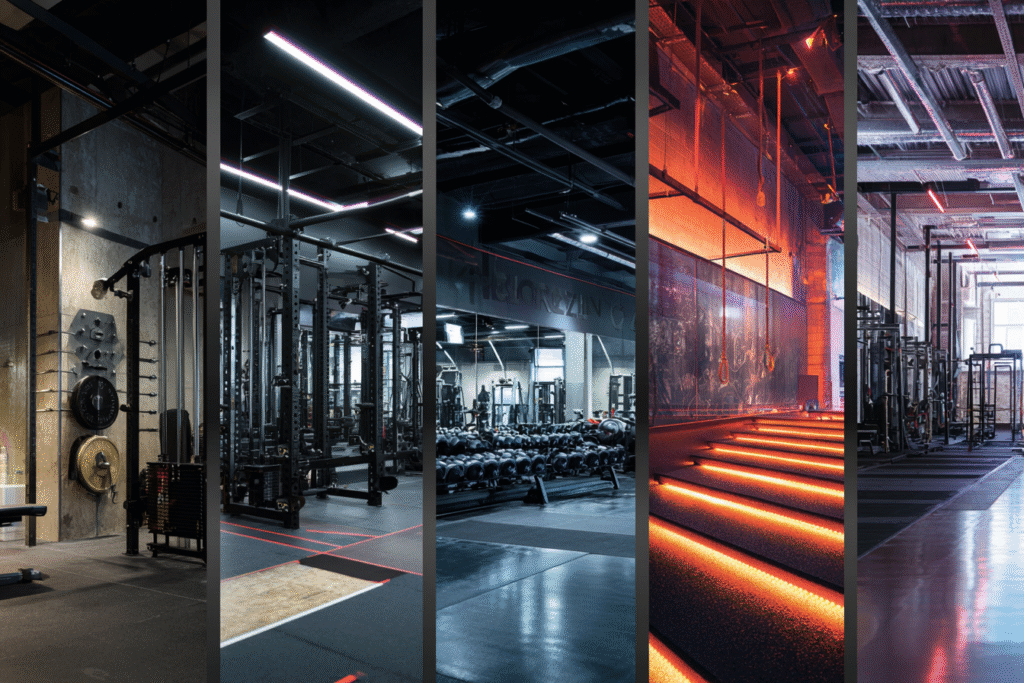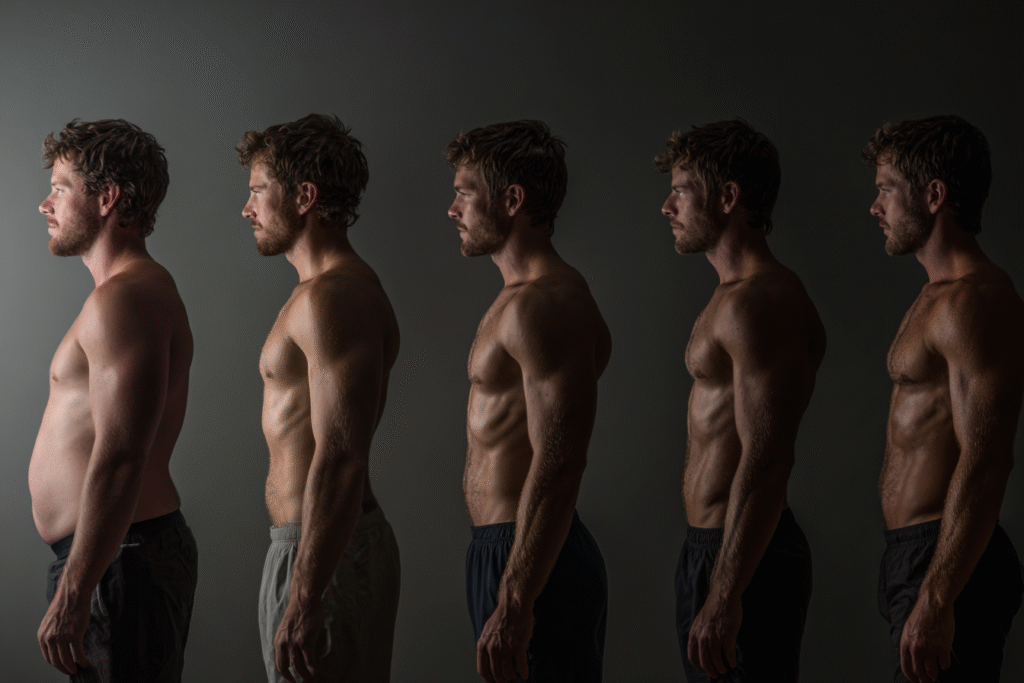Most people spend more time choosing their training method than actually training.
Note: This article is for educational and informational purposes only. See full disclaimer at the end.
Every fitness guru swears their method is revolutionary—until you realize they’re all selling variations of moving heavy things and breathing hard. Behind every six-pack promise is a simple truth: fitness still boils down to moving, loading, recovering, and repeating.
Fitness has become a buffet of branded philosophies—all promising transformation but rarely grounded in what actually sustains it.
From the raw power pursuit of powerlifting to the aesthetic precision of bodybuilding, from the time-efficient promise of HIIT to the functional movement emphasis of CrossFit—the choices can overwhelm rather than empower.
Behind the marketing noise lies a more fundamental question: what makes one training methodology more effective than another?
The answer isn’t found in before-and-after photos or celebrity endorsements, but in understanding how different approaches address the core principles of human adaptation, long-term adherence, and real-world application.
The Current Training Landscape
Let’s examine five dominant methodologies, analyzing their strengths, limitations, and ideal applications to understand what each offers the modern fitness enthusiast.

Bodybuilding: The Art of Physique Development
Bodybuilding approaches fitness as sculpture, using resistance training to create aesthetic symmetry and muscular development. The methodology employs higher volume protocols with moderate loads (typically 6-15 repetitions), emphasizing isolation exercises alongside compound movements to target specific muscle groups.
Bodybuilding’s systematic approach to hypertrophy has produced reliable results for muscle growth. The methodology’s emphasis on mind-muscle connection and training variety develops comprehensive muscular development and improves body composition effectively [3].
The methodology’s limitations include its aesthetic focus potentially overshadowing functional movement quality and health markers. Bodybuilding also requires significant time investment and may promote unhealthy relationships with food and body image in some individuals [4].
Ideal for: Those primarily motivated by physique goals, individuals who enjoy variety in exercise selection, and people who can maintain healthy perspectives on body image and nutrition.
Powerlifting: The Pursuit of Absolute Strength
Powerlifting represents the purest expression of strength development, focusing exclusively on maximizing performance in three lifts: the squat, bench press, and deadlift. Training typically involves low repetition ranges (1-5 reps) with high loads, following linear or periodized progressions designed to peak for competition.
The methodology’s strength lies in its singular focus. By concentrating on just three movement patterns, powerlifters can achieve remarkable strength gains and develop profound technical mastery. Research consistently demonstrates powerlifting’s effectiveness for maximal strength development across all three competitive lifts [1].
However, this specialization creates limitations. The narrow movement selection can lead to muscular imbalances and overuse injuries when not properly managed. Powerlifting also provides limited cardiovascular conditioning and may not translate well to activities outside the three competition lifts [2].
Ideal for: Individuals primarily interested in maximal strength development, those who enjoy technical mastery of specific movements, and people who thrive with clear, measurable progression metrics.

High-Intensity Interval Training (HIIT): Maximum Results, Minimum Time
HIIT has captured the attention of time-constrained individuals by promising significant fitness improvements through brief, intense exercise sessions. The methodology involves repeated bouts of high-intensity exercise interspersed with recovery periods, typically lasting 15-30 minutes total.
Research strongly supports HIIT’s efficiency for cardiovascular improvements, with studies showing comparable VO2max improvements to traditional endurance training in significantly less time. HIIT also produces favorable changes in body composition, insulin sensitivity, and metabolic health markers [5].
The primary limitation of HIIT lies in its cardiovascular focus. While excellent for aerobic capacity and fat loss, HIIT provides limited strength development compared to resistance-focused methodologies. The high-intensity nature can also be difficult to sustain long-term without proper recovery protocols [6].
Ideal for: Busy individuals seeking time-efficient cardiovascular improvements, those who enjoy high-intensity challenges, and people primarily focused on fat loss and metabolic health.
Functional Fitness: Movement That Transfers
Functional fitness methodologies emphasize multi-joint movements that translate to daily activities and athletic performance. This approach prioritizes movement quality, mobility, and the integration of multiple fitness components rather than specializing in any single adaptation.
Studies demonstrate functional training’s effectiveness for simultaneously improving strength, power, balance, and movement quality while enhancing daily life activities and reducing injury risk by addressing movement deficiencies [7].
This broad focus can dilute specific adaptations when programming lacks focus. Without proper programming and progression, functional fitness can become unfocused randomness rather than systematic development [8].
Ideal for: Individuals seeking well-rounded fitness, those recovering from injuries or dealing with movement limitations, and people who prioritize real-world application over specific performance metrics.

CrossFit: Blending Variety, Intensity, and Sport
CrossFit combines elements from multiple methodologies into a constantly varied program that aims to develop “increased work capacity across broad time and modal domains.” The methodology integrates weightlifting, gymnastics, and metabolic conditioning into daily workouts that change regularly.
CrossFit’s strength lies in its systematic approach to broad fitness development. The methodology produces improvements across multiple fitness domains while maintaining high levels of participant engagement through community support and competitive elements. Research indicates CrossFit’s effectiveness for improving both cardiovascular fitness and strength measures [9].
The constantly varied nature can make it challenging to perfect specific skills, and the high-intensity group environment may not suit all personality types. Critics often raise concerns about injury risk, though studies show CrossFit’s injury rates are comparable to other high-intensity methods [10].
Ideal for: Individuals seeking comprehensive fitness development, those motivated by community and competition, and people who enjoy varied, challenging workouts.
Each methodology offers distinct advantages:
Bodybuilding delivers reliable muscle growth but often neglects cardiovascular conditioning; powerlifting develops maximal strength through focused patterns while lacking versatility; HIIT offers the greatest cardiovascular return per minute but may require strength supplementation; functional fitness targets movement quality and real-life transfer; and CrossFit blends comprehensive adaptation with community engagement while requiring thoughtful scaling.
Beyond the Big Five
The methodologies we’ve examined represent the dominant approaches in Western fitness culture, but they’re not the complete picture. Mind-body practices like yoga, Pilates, tai chi, and martial arts offer profound benefits that extend beyond physical adaptation into mental clarity, stress reduction, and movement meditation.
These practices often emphasize qualities that traditional fitness methodologies may overlook: breath awareness, mindful movement, flexibility, and the integration of mental and physical training. For many individuals, a flowing yoga sequence or the meditative aspects of tai chi provide more sustainable long-term engagement than high-intensity training.

Similarly, dance, swimming, rock climbing, and countless other movement practices can serve as primary fitness methodologies. The key isn’t finding the “objectively best” approach—it’s discovering what resonates with your personality, lifestyle, and goals.
What works for one person may leave another feeling unmotivated or even injured. This is why experimentation and honest self-assessment matter more than following expert recommendations blindly.
In the end, all purposeful movement contributes to your fitness foundation. The strength you build in powerlifting transfers to better yoga poses; the flexibility from yoga enhances your powerlifting; the conditioning from HIIT supports your martial arts practice. The human body adapts beautifully to consistent challenge, regardless of the specific methodology providing that challenge.
The Evaluation Framework: What Really Matters
When comparing training methodologies objectively, several key factors determine long-term success:
Adherence and Enjoyment
The most effective training methodology is the one you’ll actually follow consistently. Research shows that enjoyment and social support are primary predictors of long-term exercise adherence. Methodologies that incorporate community elements and varied stimuli tend to maintain higher participation rates over time.
Adaptation Breadth
While specialization has its place, most individuals benefit from training that addresses multiple fitness components. Real life demands strength, endurance, mobility, and coordination simultaneously. Methodologies that develop broad adaptation tend to produce more transferable fitness improvements.
Scalability and Progression
Effective methodologies provide clear pathways for improvement while accommodating different starting points and limitations. The ability to scale intensity, complexity, and volume allows individuals to progress safely while being challenged appropriately.
Injury Prevention and Movement Quality
Sustainable training methodologies prioritize movement quality and include strategies for injury prevention. This involves addressing mobility limitations, building balanced strength, and avoiding overuse patterns that lead to chronic issues.
Real-World Application
The most valuable fitness improvements are those that enhance daily life activities and overall health markers. Training that improves functional capacity, metabolic health, and quality of life provides greater long-term value than purely aesthetic or performance-focused adaptations.

Preference and Experience: A Case for CrossFit
While no single method fits all, my personal training philosophy—and the consistent results I’ve observed coaching diverse populations in both group and individual settings—has led me to prefer the CrossFit approach.
This preference is based on six key factors that I believe are crucial for long-term training success:
Consistency through Measurability: CrossFit’s systematic approach to tracking and measuring performance creates accountability and clear progress indicators. Every workout generates data—times, loads, repetitions—that provide objective feedback on improvement.
Universal Scalability: The methodology’s ability to adapt to any fitness level or physical limitation makes it accessible to the broadest population. I’ve seen the same workout effectively challenge both elite athletes and individuals recovering from injury through appropriate scaling.
Adaptability through Variation: The constantly varied programming prevents adaptation plateaus while maintaining training stimulus. This variation also develops well-rounded fitness that translates to unpredictable real-world demands.
Traceability through Data: CrossFit’s systematic record-keeping provides detailed training history that enables smart programming decisions and long-term progress tracking. This data-driven approach appeals to individuals who appreciate objective feedback.
Community and Support: The social element built into CrossFit methodology creates natural motivation and accountability that individual training often lacks. The community aspect transforms exercise from a chore into a social activity.
Proven Effectiveness: While research continues to evolve, existing studies demonstrate CrossFit’s effectiveness for improving multiple fitness parameters simultaneously, making it efficient for busy individuals seeking comprehensive fitness development.
These factors align with what I believe makes training sustainable and effective over decades, not just months. However, the “best” methodology remains highly individual and depends on personal goals, preferences, and circumstances.
Realistic Timeline Expectations
Understanding when to expect results helps maintain motivation and adjust expectations:
Powerlifting: Initial neuromuscular adaptations and technique improvements in 2-4 weeks; measurable strength gains in 4-8 weeks; significant improvements in 8-12 weeks; advanced progress in 6+ months
Bodybuilding: Early muscle pump and training adaptations in 2-3 weeks; visible muscle changes in 4-6 weeks; noticeable physique development in 12-16 weeks
HIIT: Cardiovascular improvements and increased work capacity in 2-3 weeks; body composition changes in 6-8 weeks
Functional Fitness: Movement quality and coordination improvements in 2-4 weeks; comprehensive fitness changes in 8-12 weeks
CrossFit: Initial conditioning gains and skill acquisition in 3-4 weeks; broad fitness improvements in 12-16 weeks
Remember that consistency trumps perfection, and your individual response can vary significantly compared to others.

Making the Right Choice: Selection Strategies
The methodologies we’ve been discussing each excel in specific areas, but real-world fitness decisions rarely fit neat categories. Your optimal approach may be a pure methodology that aligns perfectly with your goals, or a strategic combination that addresses multiple priorities simultaneously.
For a Pure Approach Selection:
- Strength Focus: Powerlifting for maximal strength development
- Physique Goals: Bodybuilding for systematic muscle growth
- Time Efficiency: HIIT for cardiovascular gains per minute invested
- Comprehensive Fitness: CrossFit for broad, community-supported development
- Movement Quality: Functional fitness for injury resilience and real-world transfer
For Hybrid Approaches: Smart training often borrows from multiple methodologies rather than adhering strictly to one:
- Foundation + Specialization: Use functional movement as your base (2-3 days) while specializing in one area (1-2 days powerlifting or bodybuilding focus)
- Periodized Rotation: Cycle through 6-8 week blocks emphasizing different approaches—strength phases, conditioning phases, and movement quality phases
- Time-Based Blending: Busy periods call for HIIT efficiency, while open schedules allow for longer bodybuilding or powerlifting sessions
However, avoid the common trap of constantly switching approaches without allowing sufficient adaptation time. Your body needs consistency to create meaningful change—give any methodology or combination at least 8-12 weeks before making major adjustments. The most successful training happens when you resist the urge to chase every new trend and instead commit to systematic progression.
The key is maintaining one primary methodology as your foundation while strategically incorporating elements from others based on your current goals and constraints.
Quick Decision Framework
Still unsure which approach fits your situation? Consider these key questions:
- Time availability: Less than 30 minutes per session? → HIIT
- Primary goal: Maximal strength? → Powerlifting | Muscle size? → Bodybuilding | Overall fitness? → CrossFit
- Injury history: Movement limitations or recovering from injury? → Functional Fitness
- Motivation style: Need community and variety? → CrossFit | Prefer solo, focused work? → Powerlifting or Bodybuilding
- Experience level: Complete beginner? → Functional Fitness or beginner-focused CrossFit
Remember: there’s no permanently wrong choice. Your needs will evolve, and so should your training approach.

The Evolution of Training
The fitness industry continues evolving as we understand more about human adaptation, motivation, and long-term health outcomes.
What endures across time-tested approaches isn’t a brand or trend—it’s a system that evolves with the individual, adapts to changing capacity, and sustains engagement through meaning and momentum.
Rather than declaring one methodology universally superior, the future likely belongs to individualized approaches that combine the best elements from multiple systems. The key is finding an approach that you can execute consistently over years while gradually adapting and evolving as your needs change.
The iron doesn’t care which methodology you choose—but your consistency, progression, and enjoyment will determine whether you’re still training decades from now.
Choose the approach that makes you want to show up—day after day—for the long, evolving journey of physical development.
See you in the next insight.
Comprehensive Medical Disclaimer: The insights, frameworks, and recommendations shared in this article are for educational and informational purposes only. They represent a synthesis of research, technology applications, and personal optimization strategies, not medical advice. Individual health needs vary significantly, and what works for one person may not be appropriate for another. Always consult with qualified healthcare professionals before making any significant changes to your lifestyle, nutrition, exercise routine, supplement regimen, or medical treatments. This content does not replace professional medical diagnosis, treatment, or care. If you have specific health concerns or conditions, seek guidance from licensed healthcare practitioners familiar with your individual circumstances.
References
The references below are organized by study type. Peer-reviewed research provides the primary evidence base, while systematic reviews synthesize findings across multiple studies for broader perspective.
Peer-Reviewed / Academic Sources
- [1] Strömbäck, E., Aasa, U., Gilenstam, K., & Berglund, L. (2018). Prevalence and consequences of injuries in powerlifting: a cross-sectional study. Orthop J Sport Med, 6(5), 1-10. https://journals.sagepub.com/doi/10.1177/2325967118771016
- [2] Kompf, J., & Arandjelović, O. (2016). Understanding and overcoming the sticking point in resistance exercise. Sports Medicine, 46(6), 751-762. https://link.springer.com/article/10.1007/s40279-015-0460-2
- [3] Schoenfeld, B. J., Ratamess, N. A., Peterson, M. D., Contreras, B., & Tiryaki-Sonmez, G. (2015). Influence of resistance training frequency on muscular adaptations in well-trained men. Journal of Strength and Conditioning Research, 29(7), 1821-1829. https://journals.lww.com/nsca-jscr/fulltext/2015/07000/influence_of_resistance_training_frequency_on.8.aspx
- [4] Helms, E. R., Aragon, A. A., & Fitschen, P. J. (2014). Evidence-based recommendations for natural bodybuilding contest preparation: nutrition and supplementation. Journal of the International Society of Sports Nutrition, 11(1), 20. https://jissn.biomedcentral.com/articles/10.1186/1550-2783-11-20
- [5] Buchheit, M., & Laursen, P. B. (2013). High-intensity interval training, solutions to the programming puzzle: Part I: cardiopulmonary emphasis. Sports Medicine, 43(5), 313-338. https://pubmed.ncbi.nlm.nih.gov/23539308/
- [6] Biddle, S. J., & Batterham, A. M. (2015). High-intensity interval exercise training for public health: a big HIT or shall we HIT it on the head? International Journal of Behavioral Nutrition and Physical Activity, 12, 95. https://pubmed.ncbi.nlm.nih.gov/26187579/
- [7] Kibele, A., & Behm, D. G. (2009). Seven weeks of instability and traditional resistance training effects on strength, balance and functional performance. Journal of Strength and Conditioning Research, 23(9), 2443-2450. https://journals.lww.com/nsca-jscr/Fulltext/2009/12000/Seven_Weeks_of_Instability_and_Traditional.4.aspx
- [8] Lorenz, D., Reiman, M. P., & Walker, J. C. (2010). Periodization: Current review and suggested implementation for athletic rehabilitation. Sports Health, 2(6), 509-518. https://www.ncbi.nlm.nih.gov/pmc/articles/PMC3438871/
Systematic Reviews & Meta-Analyses
- [9] Claudino, J. G., Gabbett, T. J., Bourgeois, F., Souza, H. S., Miranda, R. C., Mezêncio, B., … & Serrão, J. C. (2018). CrossFit overview: systematic review and meta-analysis. Sports Medicine-Open, 4(1), 11. https://sportsmedicine-open.springeropen.com/articles/10.1186/s40798-018-0124-5
- [10] Meyer, J., Morrison, J., & Zuniga, J. (2017). The benefits and risks of CrossFit: a systematic review. Workplace Health & Safety, 65(12), 612-618. https://journals.sagepub.com/doi/full/10.1177/2165079916685568


